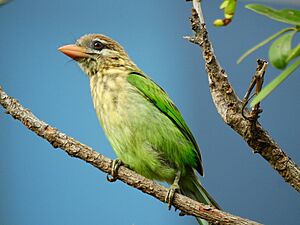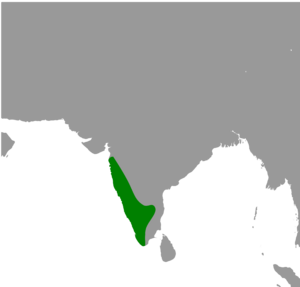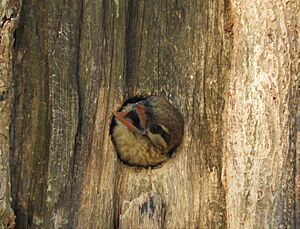White-cheeked barbet facts for kids
Quick facts for kids White-cheeked barbet |
|
|---|---|
 |
|
| Conservation status | |
| Scientific classification | |
| Genus: |
Psilopogon
|
| Species: |
viridis
|
 |
|
| Synonyms | |
|
Bucco viridis, Thereiceryx viridis, Megalaima viridis |
|
The white-cheeked barbet or small green barbet (Psilopogon viridis) is a colorful bird found in southern India. It looks a lot like the brown-headed barbet (or large green barbet, Psilopogon zeylanicus). But the white-cheeked barbet has a clear white stripe above and below its eye. You can find these birds in the forests of the Western Ghats and parts of the Eastern Ghats.
Both the white-cheeked and brown-headed barbets have similar calls. They can even live in the same dry forest areas. Like other Asian barbets, they mostly eat fruits. Sometimes, they might also eat insects. They use their strong beaks to dig holes in trees for their nests.
Contents
About Its Name
Its scientific name, Bucco viridis, was first given by Pieter Boddaert in 1783. He named it after a green barbet found in India. Later, in 1842, George Robert Gray suggested putting it in the group (genus) called Megalaima.
The first place where this bird was officially found and described was Mahé, Puducherry in southwestern India. This bird is a "monotypic" species, meaning it's the only one of its kind without different subspecies.
In 2004, scientists studied the DNA of barbets. They found that the Megalaima group of birds, including the white-cheeked barbet, were closely related to the Psilopogon group. Because of this, Asian barbets were all placed under the genus Psilopogon.
More studies in 2013 showed that the white-cheeked barbet is most closely related to the yellow-fronted barbet (P. flavifrons). This bird lives only in Sri Lanka.
Here's how the white-cheeked barbet is related to some of its close bird relatives:
|
||||||||||||||||||||||||||||
What It Looks Like
The white-cheeked barbet is about 16.5 to 18.5 centimeters long. Its head is brownish with white streaks, which sometimes makes it look like it's wearing a cap. Its beak is a light pink color. Birds in the northern parts of their range are usually a bit bigger than those in the south.
Like many other Asian barbets, these birds are mostly green. They often sit very still and upright, which makes them hard to spot in the trees.
Its Calls
During the breeding season, which starts in summer, their calls become very loud. You'll hear them a lot, especially in the mornings. Their call sounds like a repeated Kot-roo...Kotroo..., often starting with a quick trrr. This call is very similar to the brown-headed barbet's call.
On hot afternoons, they might make a single wut sound. This is similar to the calls of a collared scops owl or a coppersmith barbet. They also make harsh sounds when they are fighting with other birds.
Where It Lives
The white-cheeked barbet mainly lives along the Western Ghats in southern India. It also lives in the hills connected to this area and parts of the southern Eastern Ghats, like the Shevaroy Hills.
In some cities, like Bangalore, it's thought that the white-cheeked barbet might have taken over areas where the brown-headed barbet used to live.
Life and Habits
These barbets spend most of their time in trees and rarely go down to the ground. They get most of the water they need from the fruits they eat. If they find water in a tree hole, they might drink or even take a bath.
What It Eats
White-cheeked barbets mostly eat fruits. They especially like fruits from different types of Ficus trees, like Ficus benjamina. They also eat fruits from trees that people have brought in, such as Muntingia calabura. Sometimes, they will also eat winged termites and other insects if they get the chance.
When they are looking for food, they can be quite aggressive. They will try to chase away other barbets, koels, and other birds that eat fruit. These barbets are important in forests because they help spread seeds when they eat fruits. They also visit Bombax flowers for nectar and might help pollinate them.
Sometimes, they can be a small problem in fruit orchards because they eat the fruit. However, they are also helpful in coffee farms.
Reproduction and Life Cycle
In the Periyar Tiger Reserve, white-cheeked barbets start their breeding season in December and continue nesting until May. They are believed to stay with the same partner for more than one breeding season.
During the time they are looking for a mate, they call a lot. The male bird often feeds the female before they mate. After the eggs hatch, they call less often.
The nest hole is usually dug in dead tree branches. These barbets can be aggressive towards smaller birds that also nest in holes, like the Malabar barbet. They sometimes even destroy their nests by pecking at the entrance. Both the male and female bird work together to dig the nest hole. This can take about 20 days to finish.
About 3 to 5 days after the nest is ready, the female lays about 3 eggs. The eggs hatch in 14 to 15 days. During the day, both parents take turns sitting on the eggs. But at night, only the female stays on the eggs. The pair will protect their nests from squirrels, which sometimes try to eat the eggs. The baby birds are fed a diet rich in insects. The young birds leave the nest after 36 to 38 days.
These birds are "primary cavity nesters." This means they make their own nest holes by chiseling into a tree trunk or a thick branch. The entrance hole is usually round. They breed from December to July and sometimes raise two groups of babies in one season. In cities, they often choose trees like gulmohur (Delonix regia) and African tulip (Spathodea campanulata) for their nests. These nest holes can also be used as safe places to sleep. They might use the same tree every year but often dig a new entrance hole.




